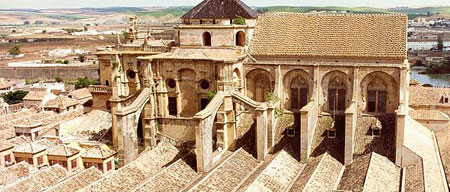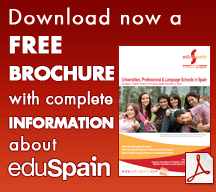Home > Study in Spain > City Guide > Córdoba
Córdoba City Guide
- Places of Interest
- Maps
- Getting to
- Getting around the city
This majestic Andalusian city is the capital of the province of the same name. Declared a UNESCO World Heritage Site, it is a sublime mixture of the various cultures that once inhabited it. In ancient times it was both a Roman and Iberian city and in the Middle Ages the capital of the Islamic Caliphate and one of the largest cities in the world. Located on the banks of the Guadalquivir river, the north is defined by the Sierra Morena mountains and adds to the spectacular scenery of the area.
Córdoba has a Mediterranean climate with the highest maximum temperatures in Europe, often exceeding 40°C and the local minimum summer temperatures are in fact the highest in Spain and Europe. There are a tremendous number of sights to see in Córdoba such as the variety of museums and the huge range of Medieval monuments going far back in history. The historic quarter is booming with a network of small streets and whitewashed courtyards and outside the city are numerous stunning little villages.
In addition to this, the city boasts a wealth of bars ideal for tasting local tapas or even during the night to watch a traditional flamenco show and this also modern city has a lively nightlife that comes into play very late at night. With fantastic not-to-be-missed year round festivals, a thorough and rich history and a sparkling culture, this city is one of Andalusia's gems and should without doubt be visited!
Places of Interest
La Mezquita-Catedral
This is the third biggest Mosque in the world, with a Cathedral built inside and would allow over 20,000 people to pray inside! It is without doubt, one of the, if not the, most significant monuments in the whole of the western Muslim World. It incorporates the evolution of the Omeyan style as well as the Gothic, Renaissance and Baroque styles of the Christian part. The mosque itself is made up of two parts; the courtyard or sahn, and the prayer hall or haram. Inside, the colour scheme of red and white arches really adds to the beauty. Entry to this jewel is 8€ however if you're willing to make the sacrifice, going earlier between 8am and 10.30am is completely free!
La Sinagoga
Córdoba's synagogue is situated in the heart of the Jewish Quarter of Cordoba and was supposedly built between 1314 and 1315. This is one of the three remaining synagogues in Spain and was in constant use until the Jews were expelled from Spain in 1492. It may be small but it speaks years of history and at the end of the 19th century it was declared a National Monument. Entry is free to anyone from the EU and for everyone else it is only 0,30€.
Medina Azahara
This magnificent city palace from as far back as 929 A.D. lies at the foot of the Sierra Morena mountains 5 miles from the sea and is amidst numerous myths and legends. Being built on three terraces, surrounded by a city wall, the Royal Castle is situated on the highest and the middle levels and the lower level was reserved for living quarters and the Mosque. Historical sources tell us that there were 10,000 people working on building the palace complex daily! The public part of the Castle was where the official visits took place. After only 70 years, at the turn of the 11th century, the city was destroyed by the succession of Civil Wars and to this day, Madinat al-Zahra is in ruins.
Fernandine Churches
These churches are a group of religious buildings built under the reign of King Fernando III "The Saint" after the conquest of Cordoba in 1236. Most were built on top of former mosques which highlighted the evident intention to erase the highly visible Islamic influence in the city. Fernando III laid out 14 parishes which are all predominantly of a Romanesque style but with clear Gothic and Mudejar influences. The buildings had many characteristics in common such as they were all of stone, their ceilings were moulded and they were built on top of former buildings. There are 7 dotted around the Axerquia area of the city and 7 in the former Medina so they are definitely not hard to come by.
The River Balcony
Located near the River Guadalquivir lies this beautiful garden which was designed by the architect Juan Navarro Baldeweg and it serves as a vantage point over the river. There is a clear contrast with the traditional image of old Cordoba in the contemporary style of the benches and other furniture pieces. This gives a stunning effect. This is a great place to come and relax and enjoy one of the more natural aspects of this beautiful city.
Museums
Carbonell Olive Oil Museum
The company Carbonell was founded in 1866 by Antonio Carbonell y Llácer and was later granted status as Official Suppliers to the Royal Household. It is, in fact, the most prestigious brand of olive oil in the world and is a highly representational symbol of Andalusia's high quality olives and olive oil. In the Carbonell Museum, the history and culture of olive cultivation are demonstrated through a unique tour and this is an excellent place to come to witness the commercialisation of the region's famous olives.
Al-Andalus Museum
This is a defensive tower which was built under the order of Enrique II de Trastamara to defend the city from attack by his brother Pedro I "The Cruel". In the 18th century it was used as a prison, in the 19th century it was a girls' school and today it is home to the Roger Garaudy Museum of the Three Cultures. This museum is an incredible insight into how the Jewish, Christian and Muslim cultures lived together in Medieval Cordoba. There are even scale models of various well know buildings and Mosques. General entry price is 2,50€ however there is a reduction to 2€ for students.
Archaeological Museum
Once the Renaissance-style palace of the Páez de Castillejo, this is now one of the most impressive archaeological museums in Spain and has been since 1965. On display are the numerous archaeological remains found in Cordoba and the province all the way from prehistoric times until the period of Arabic rule of Al-Andalus. There is a grand total of eight display rooms and three courtyards all with much to offer. As well as the artefacts themselves, the building itself is a majestic beauty which definitely deserves a visit.
Maps
Getting to Córdoba
By Air
The city itself doesn't have its own airport however it is easy to fly to Seville, Malaga or Madrid and then get further transport such as train or bus to get to Córdoba in a few hours. In fact, Córdoba can be reached by train in precisely 54 minutes with a connection linking it to Malaga Airport.
By Train
Córdoba has a highly efficient train station and the newly popular high speed train (AVE) runs from Madrid in 1 hour 45 minutes, Seville in 45 minutes and Malaga in 50 minutes. The only downside of the AVE is that it is relatively expensive however it runs regularly throughout the day. There is also a cheap option from Seville (Andalucía Express) and two daily services to Barcelona which take approximately five hours.
By Bus
The city's bus station has services and connections running throughout the whole country and there are regular buses from almost every city in Andalusia. In addition to this, there are also around 6 buses a day which depart from Estación Sur for Madrid.
Getting around the city
Córdoba is a sizeable city however everything is generally in walking distance. There is a lot to visit on the other hand and, naturally, you're going to be able to see and appreciate it much more on foot however you may get tired walking around trying to do everything. The area around the Mezquita-Cathedral is buzzing with places to eat and buy souvenirs. If you are looking for public transport to get you around, the city has a brilliant functional bus service with routes all over the city and in addition to this there is also a daily bus to Medina Azahara which is one of the most attractive sites in Cordoba.

